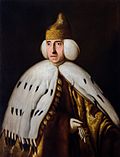
Back دوق البندقية Arabic Дож на Венецианската република Bulgarian Dux de Venècia Catalan Benátský dóže Czech Doge Danish Doge von Venedig German Δόγης της Βενετίας Greek Dux de Venecia Spanish Veneetsia doodž Estonian Doge de Venise French
| Doge of Venice | |
|---|---|
 Coat of arms | |
The last doge, Ludovico Manin | |
| Style | His Serenity |
| Residence | Palazzo Ducale |
| Appointer | Serenissima Signoria |
| Formation |
|
| First holder |
|
| Final holder | Ludovico Manin |
| Abolished | 12 May 1797 |
| Salary | 4,800 ducats p.a. (1582)[1] |
The Doge of Venice (/doʊdʒ/ DOHJ)[2][3] was the highest role of authority within the Republic of Venice (697 CE to 1797 CE).[4] The word Doge derives from the Latin Dux, meaning "leader," originally referring to any military leader, becoming in the Late Roman Empire the title for a leader of an expeditionary force formed by detachments (vexillationes) from the frontier army (limitanei), separate from, but subject to, the governor of a province, authorized to conduct operations beyond provincial boundaries.
The Doge of Venice acted as both the head of state and head of the Venetian oligarchy. Doges were elected for life through a complex voting process.[5]
- ^ Frederic C. Lane, Venice, A Maritime Republic (JHU Press, 1973), p. 324.
- ^ "doge". Dictionary.com Unabridged (Online). n.d. Retrieved 9 July 2018.
- ^ Venetian: Doxe de Venexia [ˈdɔze de veˈnɛsja]; Italian: Doge di Venezia [ˈdɔːdʒe di veˈnɛttsja]; all derived from Latin dux, "military leader")
- ^ "Republic of Venice | Map and Timeline".
- ^ "The Doge".
© MMXXIII Rich X Search. We shall prevail. All rights reserved. Rich X Search
